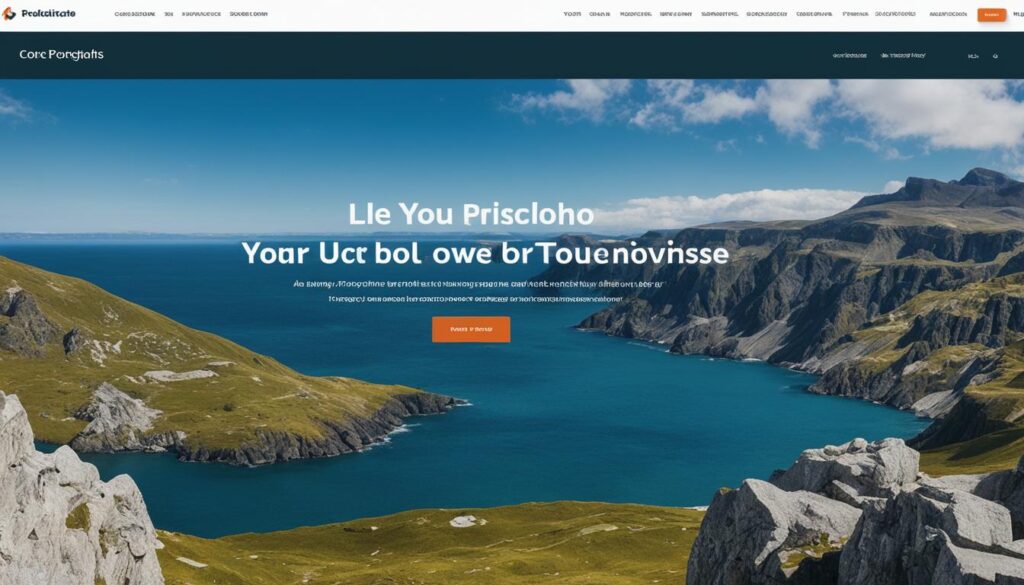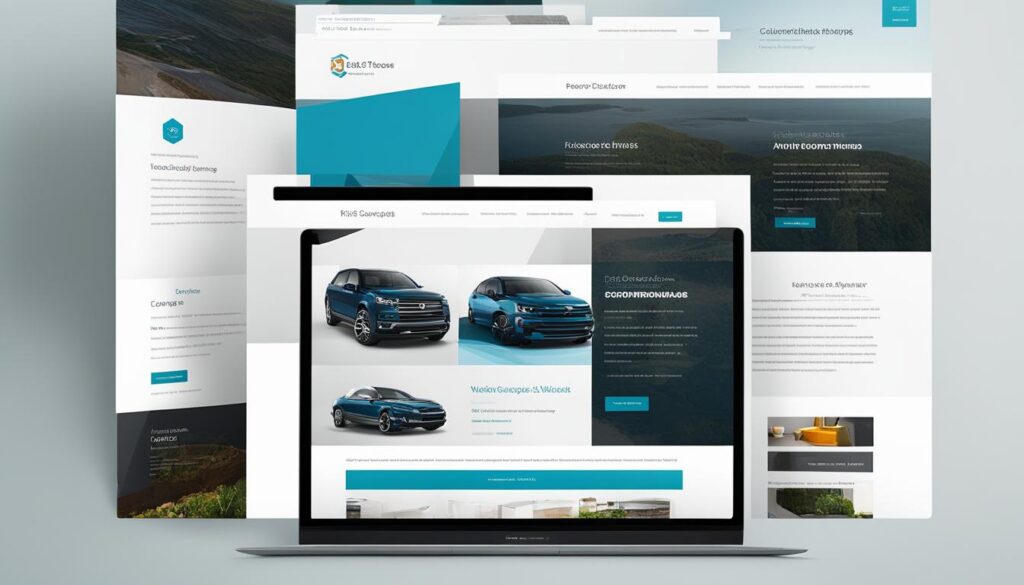Building trust with website visitors is crucial for any business in today’s digital age. As web designers, it is our responsibility to create a web design that not only captures the attention of visitors but also instills confidence and credibility. By focusing on user experience, credibility, and intuitive navigation, we can build trust with website visitors and establish a strong online presence.
A well-designed website can make a lasting impression on visitors, conveying professionalism, reliability, and a commitment to meeting their needs. Through strategic web design techniques, we can ensure that visitors feel secure, engaged, and confident in their interactions with our website. From the initial introduction to the moment they convert into customers, our web design should guide them on a seamless journey of trust and credibility.
By incorporating intuitive navigation, we can make it easy for visitors to find the information they need and navigate through our website effortlessly. A clear and straightforward interface instills confidence and reduces any potential friction that visitors may encounter. Additionally, we must provide a smooth and responsive user experience across different devices, ensuring that our website is accessible and user-friendly for everyone.
Credibility is another key aspect of building trust with website visitors. By showcasing our expertise, highlighting customer testimonials, and displaying certifications and awards, we can demonstrate our credibility and earn the trust of our visitors. Social proof and recognition from established brands can significantly contribute to building trust, as visitors are more likely to trust a website that has satisfied customers and has been recognized by reputable sources.
With every aspect of our web design, we should prioritize the needs and goals of our website visitors. By understanding their trust requirements and addressing them at each level of the hierarchy, we can create a website that not only engages and converts but also fosters long-term relationships and loyalty.
Key Takeaways:
- An effective web design builds trust with website visitors.
- User experience, credibility, and intuitive navigation are crucial for establishing trust.
- Intuitive navigation and responsive design enhance user experience and instill confidence.
- Credibility markers such as customer testimonials and certifications build trust with visitors.
- Understanding the trust hierarchy helps address specific trust needs at each level.
The Hierarchy of Trust and Its Impact on Building Relationships
The Nielsen Norman Group has developed a hierarchy of trust, adapted from Abraham Maslow’s hierarchy of needs, which identifies the different levels of trust required for relationship building. This hierarchy emphasizes the gradual process of establishing trust and how it evolves through different stages of commitment. Understanding this hierarchy can help web designers address the specific trust needs of website visitors at each level.
“Trust is the foundation of any strong relationship. Without it, relationships crumble. In the world of web design, trust plays a crucial role in building relationships with website visitors. Just like in personal relationships, trust takes time to develop and is built through consistent actions and experiences. By understanding the hierarchy of trust, web designers can strategically create websites that foster trust, leading to stronger and more meaningful connections with visitors.”
At the core of the hierarchy of trust lies the principle of relationship building. Successful relationships are built on trust, and the same applies to website-visitor relationships. As web designers, it is our responsibility to design websites that not only meet the functional needs of visitors but also establish a sense of trust and credibility.
Let’s dive deeper into the levels of trust in the hierarchy:
- Level 1: Baseline Relevance and Trust
- Level 2: Interest and Preference over Other Options
- Level 3: Personal Information Trust
- Level 4: Sensitive/Financial Information Trust
- Level 5: Willingness to Commit to an Ongoing Relationship
By addressing the trust needs at each level, we can build website-visitor relationships that are solid, trustworthy, and valuable. Let’s explore each level in detail to understand how they contribute to the overall trust-building process.
The Hierarchy of Trust
| Level | Description |
|---|---|
| Level 1: Baseline Relevance and Trust | Visitors determine if a website is relevant to their goals and if they can trust the information it provides. |
| Level 2: Interest and Preference over Other Options | Visitors evaluate if a website is their preferred choice among other options. |
| Level 3: Personal Information Trust | Visitors assess if they can trust a website with their personal information. |
| Level 4: Sensitive/Financial Information Trust | Visitors evaluate if a website can be trusted with their sensitive or financial information. |
| Level 5: Willingness to Commit to an Ongoing Relationship | Visitors consider if they are willing to establish an ongoing relationship with a website. |
Understanding the hierarchy of trust is fundamental to designing websites that effectively build trust with visitors. In the upcoming sections, we will explore each level in detail, providing insights and strategies to help you create websites that establish strong and lasting website-visitor relationships.
Establishing Trust at Level 1: Baseline Relevance and Trust

At the first level of the hierarchy of trust, we understand that website visitors need to determine if a website is relevant to their goals and if they can trust the information it provides. To meet the visitor’s goals and establish trust, our web design focuses on key factors such as baseline relevance, trust cues, and meeting visitor’s goals.
Baseline relevance ensures that our website aligns with the visitor’s specific objectives. We prioritize providing clear and concise information that directly addresses their needs. By using relevant keywords and creating informative content, we help visitors quickly understand that our website offers the solutions they are looking for.
Trust Cues: Enhancing Visitor Confidence
To build trust, we employ carefully selected trust cues that create a sense of security and credibility. These trust cues include:
- HTTPS Security: We ensure that our website has a secure connection with the HTTPS protocol. This encrypts the data exchanged between the visitor’s browser and our website, assuring them that their information is protected.
- High-Quality Images: Our website utilizes high-quality images that evoke professionalism and enhance the overall user experience. These images provide visual appeal and signify our commitment to delivering a trustworthy brand image.
- Jargon-Free Copy: We avoid using colloquialisms and jargon in our website copy. By presenting information in a clear and easily understandable manner, we eliminate any confusion and establish a connection with our visitors.
By incorporating these trust cues into our web design, we meet the visitor’s goals and provide a secure and relevant user experience. This instills confidence in our visitors, assuring them that our website is trustworthy and capable of meeting their needs.
| Trust Cues | |
|---|---|
| HTTPS Security | |
| High-Quality Images | |
| Jargon-Free Copy |
Gaining Trust at Level 2: Interest and Preference over Other Options
At this level of the hierarchy, website visitors are evaluating various options to determine which one aligns with their interests and preferences. To gain their trust and become the superior choice, web designers can employ several strategies and elements that showcase the credibility and quality of the website.
One effective way to build trust is by showcasing customer testimonials and case studies. These testimonials provide social proof that other individuals have had positive experiences with the website, increasing the visitor’s confidence in choosing it. Additionally, case studies demonstrate how the website has successfully solved problems or met the needs of its customers.
Another valuable trust-building element is certifications and awards. By displaying relevant certifications and industry awards, web designers can illustrate the website’s expertise, credibility, and recognition. These accolades serve as a testament to the superior quality and trustworthiness of the website.
“Through customer testimonials and case studies, we can demonstrate the positive experiences our customers have had, building trust and confidence in our superior website choice.”
By combining customer testimonials, case studies, and certifications, web designers can effectively communicate that their website is the preferred choice among other options. This evidence of satisfied customers, successful problem-solving, and industry recognition solidifies the website’s credibility and makes it stand out as a trustworthy and superior choice.
Building Trust at Level 3: Personal Information Trust

At the third level of the hierarchy of trust, establishing trust with personal information becomes crucial. As web designers, we understand the importance of ensuring our visitors feel confident in sharing their valuable information on our websites. To achieve this, we employ various strategies that focus on offering a valuable content offering and secure data handling practices.
One way we build trust at this level is by providing valuable content and resources that showcase our expertise and knowledge. By delivering high-quality, informative content, we demonstrate our commitment to offering value to our visitors. This valuable offering not only helps establish credibility but also encourages visitors to trust us with their personal information.
To further strengthen trust, we prioritize transparent and secure data handling practices. We make sure to provide clear contact information, allowing visitors to reach out to us if they have any questions or concerns. Additionally, we ensure our refund policies are clearly communicated, demonstrating our commitment to customer satisfaction and providing peace of mind to our visitors.
By establishing trust with personal information, we create an environment where our visitors feel safe and confident in sharing their valuable data. This trust forms the foundation for a positive website-visitor relationship, facilitating a smooth and secure user experience.
| Strategies for Building Trust at Level 3 | Benefits |
|---|---|
| Providing valuable content and resources | Demonstrates expertise and knowledge |
| Offering clear contact information | Fosters open communication and trust |
| Transparent refund policies | Reassures visitors of secure data handling |
By prioritizing trust with personal information and offering valuable resources, we establish a secure and reliable online presence. Visitors can rely on us to handle their data with care, allowing them to engage with our website confidently.
Establishing Trust at Level 4: Sensitive/Financial Information Trust

When it comes to sensitive or financial information, website visitors want to be sure that their trust is well-placed. As web designers, it is our responsibility to create an environment that assures visitors their data is secure and their privacy is respected.
To build trust at this level, we employ a variety of measures that prioritize visitor security and ensure the worthiness of their risk. One key aspect is to establish a secure and encrypted connection by implementing HTTPS protocol. This helps safeguard sensitive information exchanged between the visitor’s browser and the website’s server, preserving the confidentiality of data in transit.
Another effective strategy is to provide transactional assurances, such as Norton or Symantec logos, to instill confidence in the website’s credibility. This visually confirms to visitors that their sensitive information, such as credit card details, will be handled securely and that the website meets industry standards for secure data storage.
Clear communication of refund policies is essential in establishing trust with visitors. By outlining precise terms and conditions and prominently displaying refund policies, we show our commitment to transparency and customer satisfaction. This clarity alleviates concerns visitors may have about their financial information and reassures them that their interests are protected.
To summarize, establishing trust at Level 4 involves implementing a secure and encrypted connection, displaying transactional assurances, and clearly communicating refund policies. By taking these steps to prioritize the security of sensitive and financial information, we assure visitors that their trust is well-placed and that their data is stored securely.
Emphasizing trust with sensitive/financial information is crucial for building relationships with website visitors. The image above visualizes the importance of secure data storage and the risks involved.
Fostering Trust at Level 5: Willingness to Commit to an Ongoing Relationship

At Level 5 of the trust hierarchy, we focus on creating a comfortable connection with website visitors, encouraging their willingness to establish an ongoing relationship with our website. This level is crucial for building long-term customer loyalty and maximizing the value that visitors derive from their interactions with us. To foster trust and encourage an ongoing relationship, we implement the following strategies:
- Provide valuable and educational content: By offering high-quality and informative content, we demonstrate our expertise and commitment to providing ongoing value. Visitors will see that we are invested in serving their needs and helping them achieve their goals.
- Personalize the website experience: We understand that each visitor is unique. By personalizing the website experience based on their interests, preferences, and behaviors, we create a more tailored and meaningful interaction. This personal touch helps visitors feel seen, understood, and appreciated.
- Engage with visitors through social media platforms: Social media provides an excellent opportunity to connect with our audience on a more personal level. By regularly and authentically engaging with visitors through platforms they already use, we can foster a sense of community and build trust. This engagement showcases our commitment to open and transparent communication.
“By providing valuable content, personalizing the website experience, and engaging with visitors through social media, we can foster a comfortable and trust-filled connection, encouraging visitors to commit to an ongoing relationship.”
These strategies work together to create a comfortable connection with our visitors, making them more likely to choose us as their trusted source of information, products, or services. By establishing an ongoing relationship, we can continue to serve their needs over time, nurturing loyalty and driving mutual success.
Remember, building trust is an ongoing process rooted in consistent effort and dedication. By prioritizing the comfort and satisfaction of our visitors, we can lay a solid foundation for a lasting and mutually beneficial relationship.
| Strategies | Benefits |
|---|---|
| Providing valuable and educational content | – Demonstrates expertise and commitment – Offers ongoing value – Helps visitors achieve their goals |
| Personalizing the website experience | – Creates a tailored and meaningful interaction – Makes visitors feel seen and understood |
| Engaging with visitors through social media platforms | – Fosters a sense of community – Builds trust through open communication |
Designing for Trust: Visual Elements that Build Credibility

The visual design of a website plays a crucial role in establishing trust with visitors. At our company, we understand the importance of creating a professional and coherent design that leaves a lasting impression. A visually appealing website not only attracts users but also builds credibility and enhances the overall user experience.
Creating a Professional Appearance
When it comes to design, professionalism is key. We ensure that our websites have a sleek and polished look, reflecting the high standards of our clients’ businesses. By using clean lines, intuitive layouts, and consistent branding elements, we establish a professional appearance that instills confidence in our visitors.
One of the factors that contribute to a professional appearance is the use of high-quality images. Instead of relying on generic stock photos, we source unique and compelling visuals that resonate with our clients’ brands. These authentic images create a sense of credibility and authenticity, helping visitors connect with the brand on a deeper level.
Coherent Design for Seamless User Experience
A coherent design is essential for ensuring a seamless user experience. We focus on creating a unified visual look by maintaining consistency in font use, color schemes, and design elements throughout the website. This level of coherence enhances the overall user experience, making it easy for visitors to navigate and find the information they need.
In addition, we pay attention to the placement and alignment of design elements, ensuring everything is visually balanced and well-organized. This creates a sense of order and professionalism, making it easier for visitors to trust the website and the brand behind it.
“A visually appealing and coherent design helps establish trust with website visitors by signaling professionalism, attention to detail, and a commitment to delivering a quality user experience.”
Fixing Broken Elements for Trustworthiness
No matter how well-designed a website is, broken or misaligned elements can undermine trust and credibility. We make it a priority to fix any broken links, images, or layouts to ensure a seamless browsing experience for our visitors. By eliminating these issues, we demonstrate our dedication to providing a trustworthy and reliable online presence.
By incorporating these visual elements and design principles into our websites, we design for trust, creating a professional appearance and coherent design that builds credibility and establishes a strong foundation of trust with visitors.
| Benefits of Designing for Trust | Visual Elements |
|---|---|
| Enhanced credibility | High-quality images |
| Increased user trust | Consistent branding elements |
| Improved user experience | Coherent layouts and designs |
| Higher conversion rates | Fixed broken elements |
Designing for trust is not just about creating an aesthetically pleasing website; it’s about establishing a professional appearance, creating a coherent design, and fixing any broken elements. By prioritizing these visual elements, we build credibility and trust with our website visitors, ultimately leading to higher conversion rates and the growth of our clients’ businesses.
Leveraging Social Proof and Established Brands

Social proof and established brands play a crucial role in building trust with website visitors. By showcasing customer testimonials and reviews that highlight the positive experiences of past customers, web designers can leverage social proof to instill confidence in potential visitors. These testimonials serve as powerful endorsements, demonstrating that others have had positive interactions with the website and encouraging visitors to trust in the brand.
In addition to customer testimonials, prominently displaying logos of well-known brands that the website has worked with or media mentions can further enhance trust. These marquee client logos serve as visual proof of the website’s credibility and establish an immediate connection with visitors, as they recognize and trust these esteemed brands. Furthermore, media mentions contribute to the website’s authority and demonstrate that it has been recognized by reputable sources.
Here are a few ways web designers can effectively leverage social proof and established brands:
- Include customer testimonials on the website’s homepage or landing pages. These testimonials should showcase the positive experiences and results that customers have had with the brand or product.
- Showcase logos of well-known brands that the website has partnered with or served. This reinforces the website’s reputation and builds trust with visitors who are familiar with these established brands.
- Display media mentions, such as awards, accolades, or positive press coverage. These endorsements from trusted sources enhance the website’s credibility and make visitors more likely to trust the brand.
By incorporating social proof and leveraging established brands, web designers can create a compelling online presence that builds trust with website visitors. These elements provide tangible evidence of the website’s reliability and can significantly influence the decision-making process of potential customers.
Take a look at the following example:
“I’ve never been more satisfied with an online shopping experience. The website’s customer testimonials were what convinced me to make a purchase, and I’m glad I did. The quality of the product exceeded my expectations, and the customer service was outstanding. I highly recommend this website to anyone in search of reliable and trustworthy brands.” – Emily Johnson
As you can see, customer testimonials provide social proof and validate the website’s credibility. The inclusion of well-known brand logos and media mentions enhances its trustworthiness and credibility further.
Building Trust with Web Design for Improved Conversions
Building trust with website visitors is a critical aspect of web design that can significantly impact conversions and cultivate a loyal customer base. At [Your Company Name], we understand the importance of establishing trust in the online landscape. By strategically focusing on elements such as user experience, credibility, and intuitive navigation, we can help you create a website that not only attracts visitors but also instills trust in their minds.
One of the key foundations for building trust online is by ensuring a secure connection. By implementing HTTPS security measures, visitors can feel confident that their information is protected from prying eyes. Additionally, we emphasize the importance of providing valuable content that demonstrates your expertise and knowledge. This valuable offering not only showcases your credibility but also allows visitors to see firsthand the benefits of choosing your products or services.
Personalization is another aspect that plays a vital role in trust-building. By tailoring the user experience based on visitors’ interests and behaviors, your website can create a comfortable connection with potential customers. Furthermore, our web design experts understand the significance of intuitive navigation, ensuring that visitors can effortlessly find what they are looking for and feel guided throughout their journey.
At [Your Company Name], we believe that every aspect of web design should be meticulously crafted to build trust with your website visitors. By focusing on trust online, you can achieve improved conversions and establish a loyal customer base. Contact us today to learn more about how our web design services can help you build trust and grow your business.
FAQ
Why is building trust with website visitors important?
Building trust with website visitors is essential for any business in today’s digital age. It helps establish credibility, enhances the user experience, and can lead to improved conversions and a loyal customer base.
How can web design help build trust with website visitors?
Web design can build trust with website visitors by focusing on elements such as user experience, credibility, and intuitive navigation. By providing a secure, responsive, and credible online presence, web designers can create a website that instills trust in visitors.
What is the hierarchy of trust, and how does it impact building relationships?
The hierarchy of trust, adapted from Abraham Maslow’s hierarchy of needs, identifies the different levels of trust required for relationship building. It emphasizes the gradual process of establishing trust and how it evolves through different stages of commitment.
How can websites address the trust needs of visitors at the first level of the hierarchy?
Websites can address the trust needs of visitors at the first level by ensuring that the website is HTTPS secure, using high-quality images, and avoiding colloquialisms and jargon in website copy. These trust cues can help visitors feel confident that their needs will be met and that the website has their best interests at heart.
How can websites build trust with visitors at the second level of the hierarchy?
Websites can build trust with visitors at the second level of the hierarchy by showcasing customer testimonials and case studies, as well as certifications and awards. These social proof elements demonstrate that the website is the preferred choice among other options and has satisfied customers.
How can websites earn trust with visitors regarding their personal information?
Websites can earn trust with visitors regarding their personal information by offering valuable content and resources that demonstrate their expertise. Additionally, providing clear contact information and transparent refund policies can reassure visitors that their personal information will be handled securely and that they can trust the website with their data.
What measures can websites take to build trust with visitors regarding sensitive or financial information?
Websites can build trust with visitors regarding sensitive or financial information by ensuring that the website has a secure and encrypted connection (HTTPS), using transactional assurances such as Norton or Symantec logos, and clearly communicating refund policies. These measures demonstrate that the website values visitor’s privacy and is committed to protecting their sensitive information.
How can websites foster trust with visitors to establish an ongoing relationship?
Websites can foster trust with visitors to establish an ongoing relationship by providing valuable and educational content, personalizing the website experience based on visitor’s interests and behaviors, and engaging with visitors through social media platforms. These strategies show that the website is dedicated to providing ongoing value and building a long-term relationship with its audience.
What role does visual design play in building trust with website visitors?
Visual design plays a crucial role in building trust with website visitors. Web designers should strive for a professional and coherent design that creates a unified visual look. This includes using high-quality images, avoiding stock photos, and maintaining consistency in font use and design elements throughout the website.
How can websites leverage social proof and established brands to build trust?
Websites can leverage social proof and established brands to build trust by including customer testimonials and reviews that demonstrate the positive experiences of past customers. Additionally, prominently displaying logos of well-known brands or media mentions can borrow trust and establish credibility. These elements show visitors that the website is trustworthy and has been recognized by reputable sources.
Why is trust online important for businesses?
Trust online is important for businesses because it leads to improved conversions and a loyal customer base. By focusing on elements of web design that build trust with website visitors, businesses can establish credibility, enhance the user experience, and ultimately drive success.

Leave a Reply